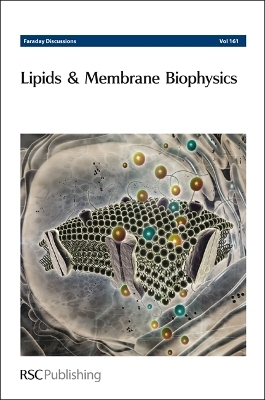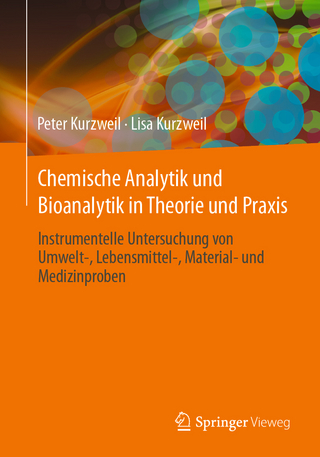
Lipids and Membrane Biophysics
Royal Society of Chemistry (Verlag)
978-1-84973-688-6 (ISBN)
One of the key challenges in biophysics and chemical biology is gaining an understanding of the underlying physico-chemical basis of the highly complex structure and properties of biomembranes. It used to be thought that the lipid component played a mainly passive role, simply acting as a self-assembled bilayer matrix within which the active protein components functioned. However, it has now become clear that there is a intimate two-way interplay between the lipid and the protein components in determining membrane structure, organization and dynamics, and that lipids play many active roles in biological function. Concepts such as lateral segregation and domain formation, lateral pressure, curvature and curvature elasticity have attracted enormous interest in recent years, although their validity when applied to real biomembranes remains unclear or even obscure. This Faraday Discussion considered recent developments in the study of biomembrane structure, ordering and dynamics, with particular emphasis on the roles of lipids in these phenomena. As well as discussing new experimental and theoretical findings and novel methodologies, the meeting focused on exploring the relevance of concepts from amphiphile self-assembly and soft matter physics to understanding biomembranes.
Faraday Discussions documents a long-established series of Faraday Discussion meetings which provide a unique international forum for the exchange of views and newly acquired results in developing areas of physical chemistry, biophysical chemistry and chemical physics. The papers presented are published in the Faraday Discussion volume together with a record of the discussion contributions made at the meeting. Faraday Discussions therefore provide an important record of current international knowledge and views in the field concerned. The latest (2012) impact factor of Faraday Discussions is 3.82.
Preface;Introductory Lecture: Basic quantities in model biomembranes;PAPERS AND DISCUSSIONS;
Switchable domain partitioning and diffusion of DNA origami rods on membranes;
The effect of cholesterol on the intrinsic rate of lipid flip–flop as measured by sum-frequency vibrational spectroscopy;
Computer simulations of the phase separation in model membranes;
STED microscopy detects and quantifies liquid phase separation in lipid membranes using a new far-red emitting fluorescent phosphoglycerolipid analogue;
Critical point fluctuations in supported lipid membranes;
General discussion;
Lipid phase behaviour under steady state conditions;
Transient pearling and vesiculation of membrane tubes under osmotic gradients;
Mode specific elastic constants for the gel, liquid-ordered, and liquid-disordered phases of DPPC/DOPC/cholesterol model lipid bilayers;
Tuning the aggregation behaviour of single-chain bolaphospholipids in aqueous suspension: from nanoparticles to nanofibres to lamellar phases;
Polycontinuous geometries for inverse lipid phases with more than two aqueous network domains;
Physical properties of mixed bilayers containing lamellar and nonlamellar lipids: insights from coarse-grain molecular dynamics simulations;
General discussion;
Spontaneous tubulation of membranes and vesicles reveals membrane tension generated by spontaneous curvature;
Formation and analysis of topographical domains between lipid membranes tethered by DNA hybrids of different lengths;
Molecular view on protein sorting into liquid-ordered membrane domains mediated by gangliosides and lipid anchors;
Gaussian curvature elasticity determined from global shape transformations and local stress distributions: a comparative study using the MARTINI model;
Elastic properties of polyunsaturated phosphatidylethanolamines influence rhodopsin function;
Anomalous and normal diffusion of proteins and lipids in crowded lipid membranes;
General discussion;
Interactions of drugs and amphiphiles with membranes: modulation of lipid bilayer elastic properties by changes in acyl chain unsaturation and protonation;
Cell cycle dependent changes in membrane stored curvature elastic energy: evidence from lipidomic studies;
Impact of oxidized phospholipids on the structural and dynamic organization of phospholipid membranes: a combined DSC and solid state NMR study;
Materials characterization of the low temperature sensitive liposome (LTSL): effects of the lipid composition (lysolipid and DSPE–PEG2000) on the thermal transition and release of doxorubicin;
Segregated ordered lipid phases and protein-promoted membrane cohesivity are required for pulmonary surfactant films to stabilize and protect the respiratory surface;
Gibbs energy determinants of lipoprotein insertion into lipid membranes: the case study of Ras proteins;
General discussion;
Concluding remarks;
| Erscheint lt. Verlag | 10.2.2013 |
|---|---|
| Reihe/Serie | Faraday Discussions ; Volume 161 |
| Mitarbeit |
Sonstige Mitarbeit: Royal Society of Chemistry |
| Verlagsort | Cambridge |
| Sprache | englisch |
| Maße | 156 x 234 mm |
| Gewicht | 1060 g |
| Themenwelt | Naturwissenschaften ► Biologie ► Biochemie |
| Naturwissenschaften ► Chemie | |
| Naturwissenschaften ► Physik / Astronomie ► Angewandte Physik | |
| ISBN-10 | 1-84973-688-X / 184973688X |
| ISBN-13 | 978-1-84973-688-6 / 9781849736886 |
| Zustand | Neuware |
| Haben Sie eine Frage zum Produkt? |
aus dem Bereich


